Great Orme Tramway/Railway
History
Powers to build a 3ft 6in-gauge tramway from Llandudno to near the summit of the Great Orme were obtained on the 23rd May 1898 under the Great Orme Tramways Act, 1898. The act also authorised the incorporation of a company — the Great Orme Tramways Company — to build and operate the tramway.
Construction commenced in April 1901, the line opening to the public just over two years later on the 31st July 1902. Given that the parliamentary powers only allowed three years to complete the tramway, which would have expired in May 1901, some dispensation must have been sought from the Board of Trade for the extra time needed. Unusually for a British tramway, the line was cable hauled, an absolute necessity given the extreme gradients it had to negotiate (a maximum of 1 in 10.3). The line ascended approximately 550ft in 0.96 miles, starting at a terminus in Old Road, Llandudno (altered in 1904 and now known as Victoria Station) and travelling roughly northwestwards to Summit Station, which was situated close to the top of the Great Orme (679ft). Rather than a single continuous cable, the line was split into two sections — lower and upper — with the engine house situated in the middle at Half Way Station, where passengers changed cars.
The tramway was an instant success, carrying large numbers, even though the first services only went as far as Half Way Station, the take-up of shares having been insufficient to fund the whole line in one go; the upper section opened to passengers one year later on the 8th July 1903. Other than a brief experiment with winter operation in 1902/3, the tramway always closed for winter, operation following the main tourist season.
The tramway never struggled for passengers, but seems to have been inefficiently managed in the early years, with some very short operating seasons (as little as six weeks one year). Things did, however, settle down, and the tramway seems to have generally made a profit — up until 1931 — paying its shareholders, on average, a dividend of 6%. The tramway even operated during the Great War, though only for 22 days in 1918 as the company was unable to purchase a new cable due to war-time restrictions. It is amazing to think that the line's success during the first 30 years of its life was achieved without operating on Sundays, Llandudno Urban District Council refusing to grant permission, doubtless due to the strongly held religious convictions of the time.
The company's largely uneventful existence was, however, to come to a shattering halt on the 23rd August 1932, when a drawbar broke and a car ran away, the driver and a small girl being killed, and several others seriously injured. Whilst accidents happened on most tramways, the difference here was that the very effective automatic emergency brake had been deliberately disabled by staff. Whilst a life-saver in a real emergency, it was possible to activate the brake by poor control of the cable, and once triggered, it took 4 hours to disengage it, during which time the tramway could not be used. Someone, at some point, had taken the decision that the tramway was better off without the device, the automatic brakes having in fact been disabled on all four passenger cars, probably for the best part of 25 years, and purportedly without the knowledge of the directors. To make matters worse, the subsequent Ministry of Transport inquiry uncovered several other serious breaches of regulations, so the tramway, which closed on the day of the accident, was to remain closed for a just over one-and-a half years.
Not unsurprisingly, the insurance company refused to pay out, and the company, being unable to meet the claims, had no choice but to seek a winding up order, which was granted on the 24th July 1933. A new emergency brake was eventually designed, tested and approved (with the buy-in of the creditors), and services recommenced on the 17th May 1934. Passengers returned, and in December of that year, the tramway was sold as a going concern to a local syndicate, pending the creation of a limited company. The new company — the Great Orme Railway Limited — took over on the 30th March 1935. The legal situation, as well as the temporary rates and charges that were in force at the time, were regularised on the 30th March 1936 by the Great Orme Tramways Act, 1936.
The tramway returned to its uneventful and profitable existence, though after the Second World War, clouds were gathering on the GORL's horizon, as Llandudno UDC, which had the right to purchase the line at seven-year intervals, was taking an interest in the tramway. The council duly served notice of its intent in 1947, taking ownership on the 1st January 1949. The track was renewed, and in 1957, the expensive coal-fired steam winders were replaced with modern electric ones, something the company had considered, but had been reluctant to do given the spectre of municipalisation.
Other than local authority reorganisations (Aberconwy District Council on 1st April 1974, then Conwy County Borough Council on the 1st April 1996), a change of name on the 31st July 1977 — back to the Great Orme Tramway — and major infrastructure renewal, nothing of note has disturbed the operation of the tramway, and it continues to operate successfully to the present day.
Uniforms
Photographs of the first 20 years or so of the Great Orme Tramway, which clearly show crew members, are extremely rare, so very little can be said about this era with any degree of confidence. The early photograph below would seem to suggest that drivers initially wore smart single-breasted jackets with lapels, along with a shirt and tie, and a soft-topped peaked cap, the entire ensemble being devoid of insignia; however, there is a possibility that photo may in fact show a 'proving' run, an operation which would probably have preceded the issuing of uniforms. Photographs taken in the 1930s through to the 1950s clearly show that drivers and conductors wore double-breasted jackets with four pairs of buttons, and lapels, apparently without any insignia. Headgear took the form of a soft-topped cap with a glossy peak, bearing a large oval cap badge (of unknown pattern), probably metallic (judging by the photographs below, which show a strong reflection). Given the sparsity of the photographic record, it may well be that these uniforms, or a similar style, were worn during the preceding decades.
The vast majority of photographs taken from the 1940s through to the 1960s show crews wearing long cotton dustcoats (probably light brown), presumably over their uniform jackets, or in hot weather, instead of the jackets; these coats appear to have been plain, i.e., without badges of any kind. By the 1960s, however, an increasing proportion of photographs show crews without uniforms, or with only the light-coloured dustcoats.
A uniform policy appears to have been reintroduced once again in the 1970s/80s, possibly at the same time as the rebranding of 1977 — to the Great Orme Tramway from the Great Orme Railway — after which time photographs show staff wearing light-blue shirts and ties, along with single-breasted jackets with gold embellishment on the cuffs; caps seem not to have been worn. In recent decades (the late 1990s through to the present day), staff are frequently seen in waterproof and/or fleece jackets, with a large logo emblazoned on the bearer's left-hand breast; once again, the wearing of headgear of any kind appears to have been eschewed.
As far as I am aware, other than the manager, the Great Orme Tramway never employed inspectors or senior uniformed staff of any kind. Additionally, although the GOT may have employed female staff during the Great War and the Second World War, there is currently no evidence whatsoever — either documentary or photographic — that would suggest that they ever did so.
Further reading
For a more detailed history of the line, see: 'The Great Orme Railway' by R C Anderson (Light Railway Transport League; c1950s), later reprinted as 'Great Orme Tramway, The First 80 Years' (Light Rail Transit Association; 1982).
Images
Drivers and conductors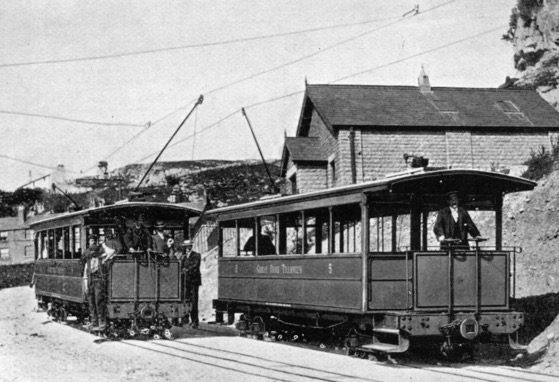
Tramcars No 4 and 5 at the lower section passing loop — photo undated, but probably early Edwardian. The tramcars carried curtains for the first two years, so the above photograph was either taken after this, or more probably, judging by the pristine condition of the vehicles and track, and the lack of passsengers, this was a proving run in 1902. Photo courtesy of the Tramways and Light Railway Society, with thanks to David Voice.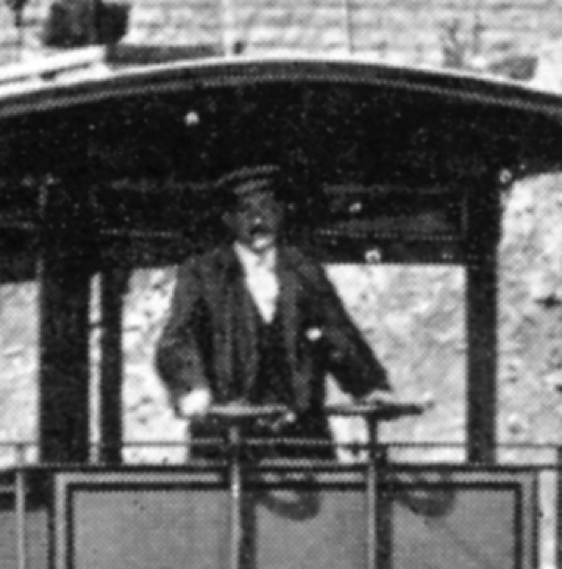
An enlargement of the above photograph showing the driver, who appears to be wearing a smart jacket and soft-topped peaked cap, without a cap badge. If this was indeed a proving run, the lack of uniform may merely mean that they had yet to be issued.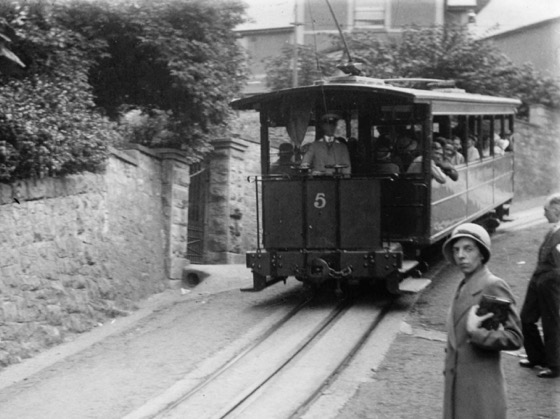
Great Orme Tramway No 5 in Old Road — photo undated, but judging by the livery and the fashions, probably taken in the 1930s. Photo courtesy of the Tramways and Light Railway Society, with thanks to David Voice.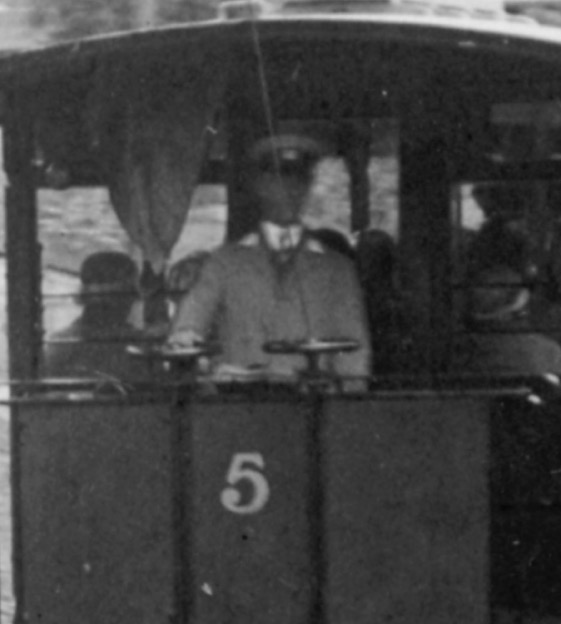
An enlargement of the above photograph showing the conductor, who is wearing a light-coloured dustcoat and a cap bearing a metallic badge.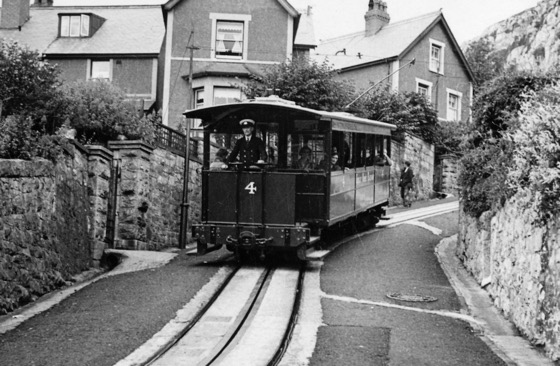
Virtually the identical location, but this time Tramcar No 4 — photo undated, but probably taken in the 1950s. Photo courtesy of the Tramways and Light Railway Society, with thanks to David Voice.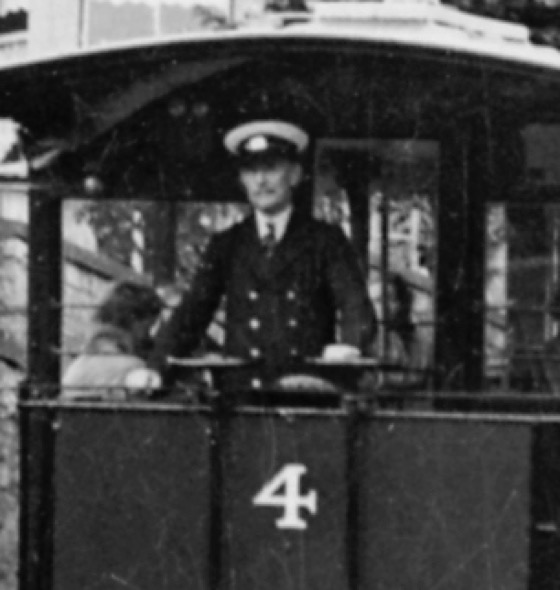
An enlargement showing the driver, who is clearly wearing a double-breasted uniform jacket, along with a cap bearing a highly reflective — i.e., metallic — cap badge. 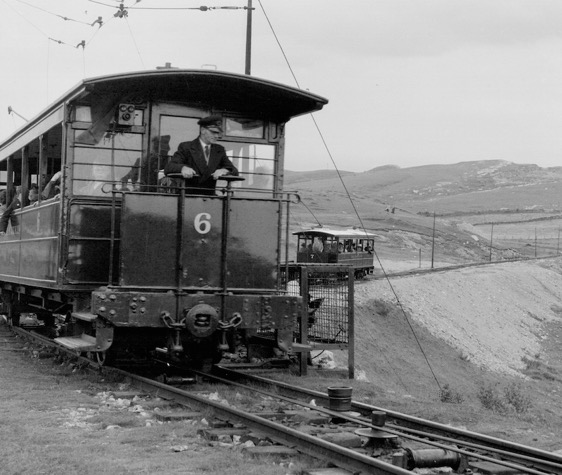
Tramcars No 6 and No 7 at the upper section passing loop on the 30th August 1953. Photo by R B Parr, courtesy of the National Tramway Museum. 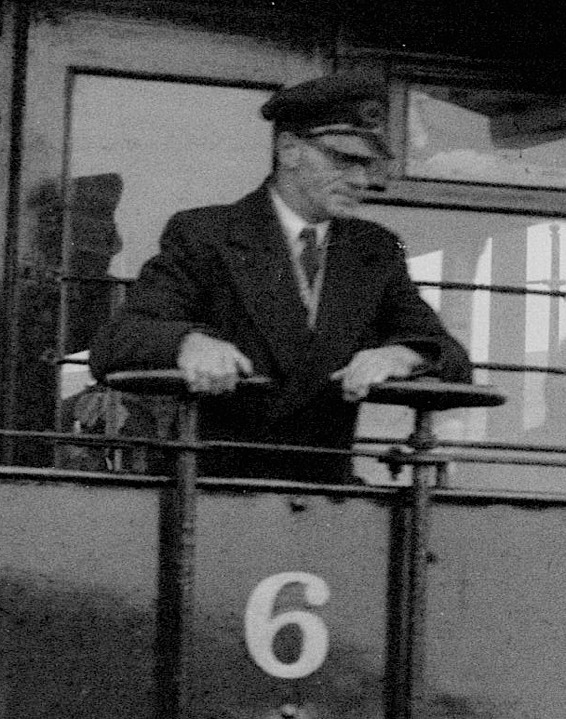
An enlargement of the above photograph showing the driver of Tram No 6. Whilst the cap would appear to be a formal issue (with oval cap badge), the overcoat is probably the driver's own, i.e., self-purchased.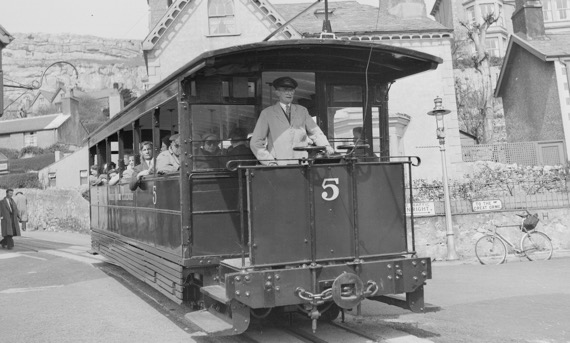
Tramcar No 5 just entering the Victoria Station terminus — photo undated, but probably taken in the 1950s. Photo by F Wilson, courtesy of the National Tramway Museum. 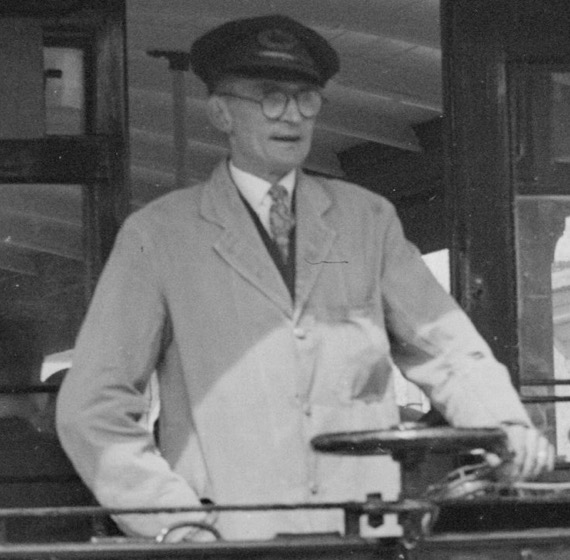
An enlargement of the above photograph showing the driver, who is wearing a light-coloured summer dustcoat. The soft-topped cap bears a cap badge, the precise form of which remains unknown.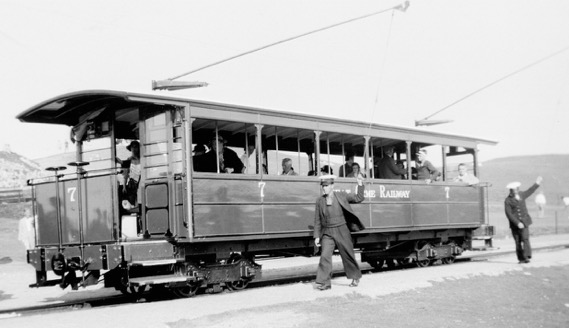
The driver and conductor of Tram No 7 reversing the communication poles at the summit terminus — undated, but probably taken in the late 1940s or early 1950s. Photo by M J O'Connor, courtesy of the National Tramway Museum. 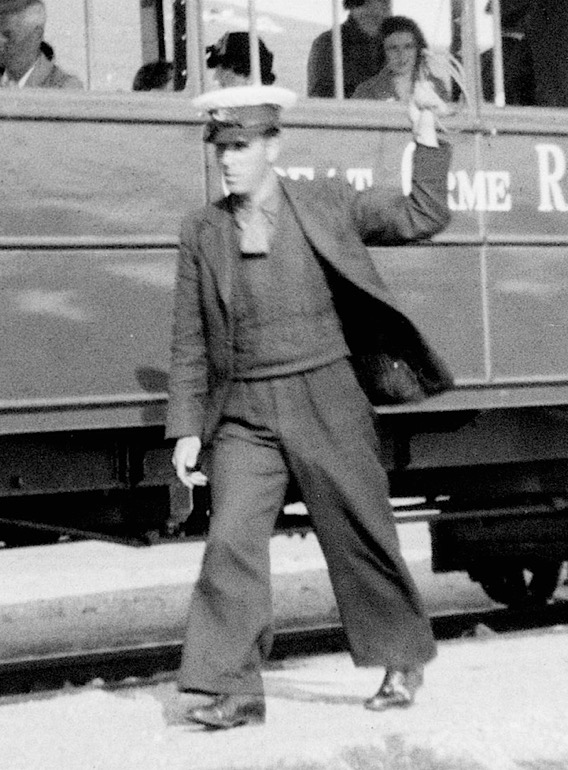
An enlargement of the above photograph showing the driver who, apart from his cap, appears to be wearing informal attire.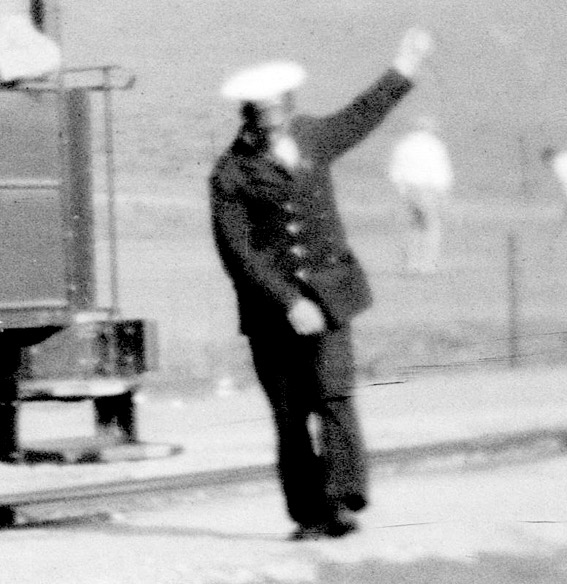
Another blow-up of the above photograph, this time showing the conductor, a grade which appears to have largely evaded the attention of photographers, probably because most shots were of trams approaching the cameraman. He is clearly wearing a double-breasted uniform jacket.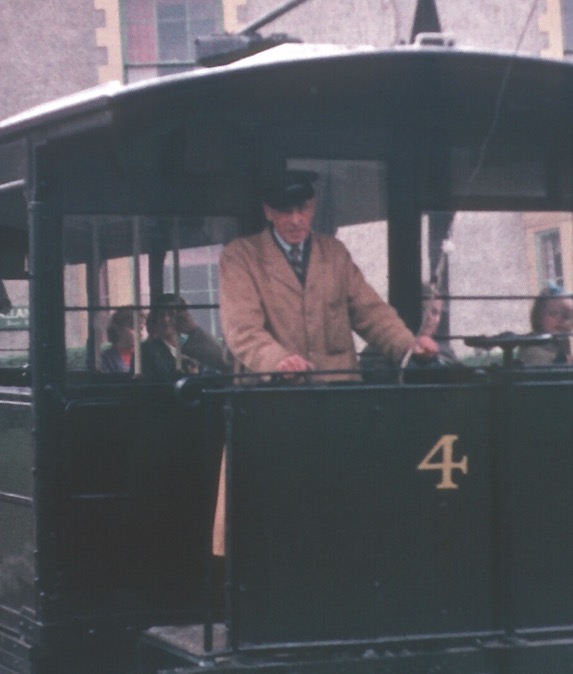
The driver spares a glance for the cameraman as he eases Tramcar No 4 into Victoria Street Station — photo undated, but probably taken in the early 1960s. Photo courtesy of the Tramways and Light Railway Society, with thanks to David Voice.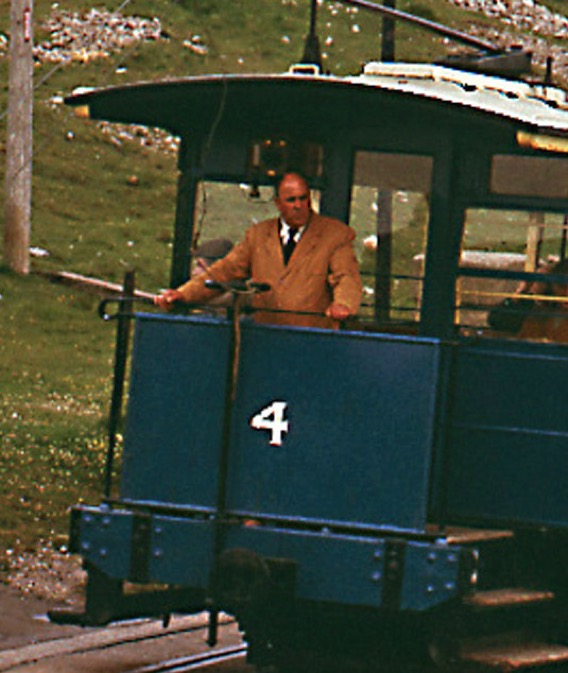
Tramcar No 4 photographed on the 2nd June 1968. Photo courtesy of the Tramways and Light Railway Society, with thanks to David Voice.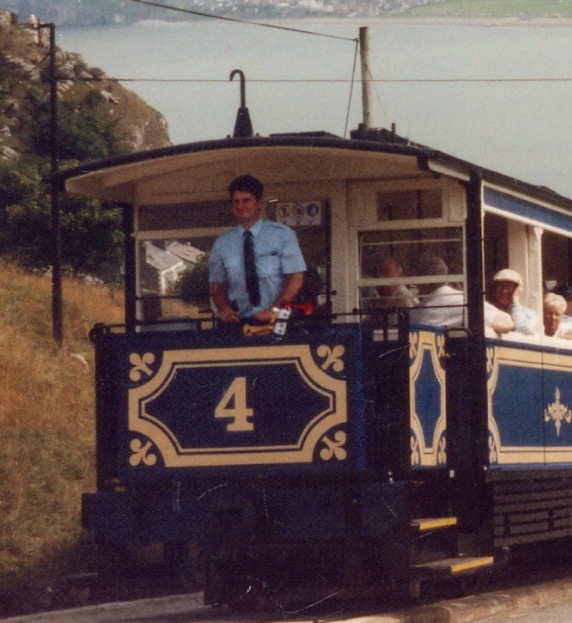
The driver of Tramcar No 4 in short-sleeved shirt and tie — photo undated, but probably taken in the 1980s or 1990s. Photo courtesy of the Tramways and Light Railway Society, with thanks to David Voice.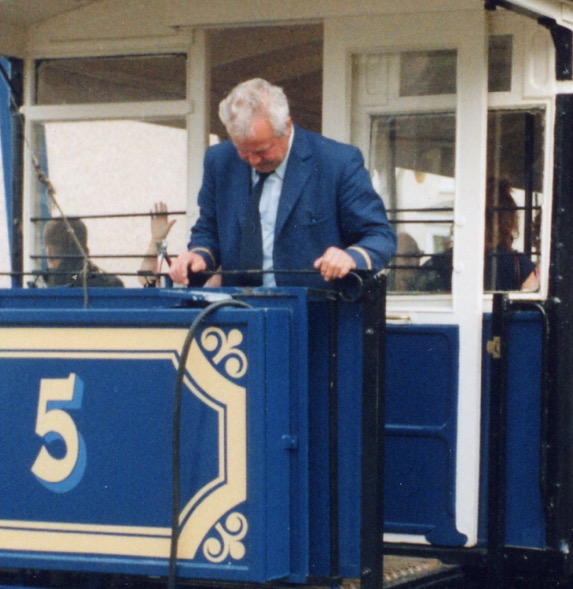
A driver or conductor aboard Tramcar No 5, in smart blue jacket with gold cuff embellishment at Victoria Street Station — photo undated, but probably taken in the 1990s or early 2000s. Photo courtesy of the Tramways and Light Railway Society, with thanks to David Voice.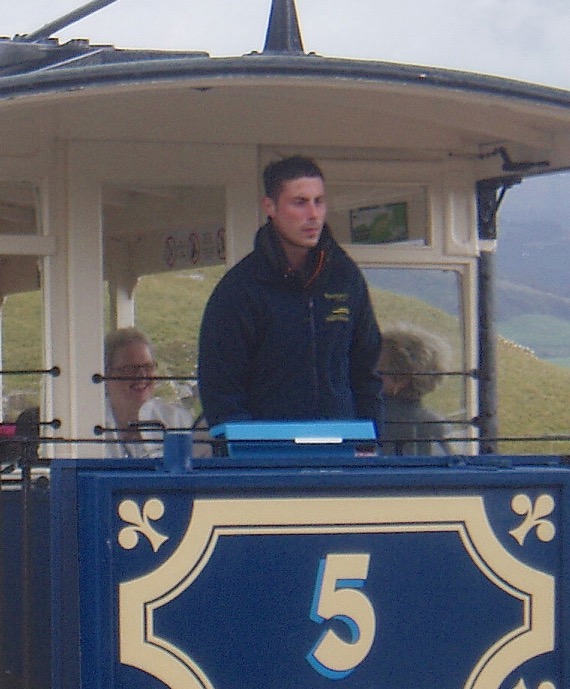
The driver of Tramcar No 5 in what appears to be a formal fleece-style jacket with logo — photo undated, but probably taken in the first decade of the 21st Century. Photo courtesy of the Tramways and Light Railway Society, with thanks to David Voice.